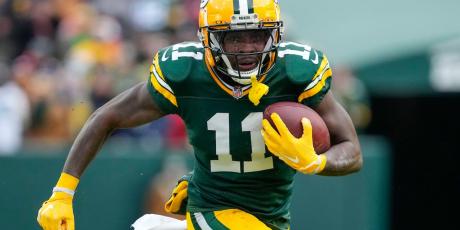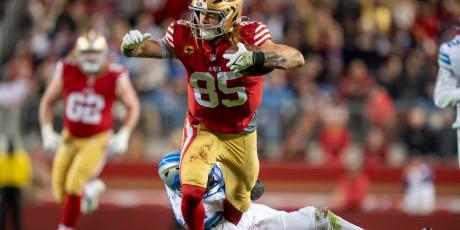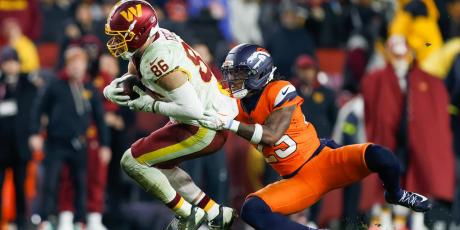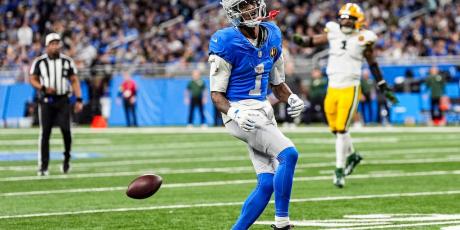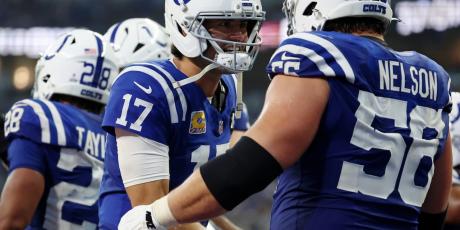How Late Should You Draft Your Fantasy Football QB?

Does late-round quarterback work?
Yes.
Well, that turned into the shortest article I have ever written. They tell me articles should last more than three sentences, though, so let’s see if we can fill out that introduction. With the conclusion already written, I’ll go ahead and put some meat on the bone.
What Does Late-Round Quarterback Mean?
Late-round quarterback (LRQB) is a draft philosophy that heavily emphasizes skill positions (running back, wide receiver, and tight end) in the early rounds while waiting to select a quarterback until well into the draft. Two main facts support the argument for waiting on quarterback:
- The position is extremely replaceable. Even in a 12-team league, roughly 12-16 starting quarterbacks will be on your waiver wire every week, meaning you can replace your starter essentially for free. So you can wait and draft a bad quarterback knowing that even if he does not pan out, you will be able to find a replacement on the cheap.
- Quarterback is the most predictable of all positions in fantasy football. Given their role in the NFL, quarterbacks touch the ball far more often than any other player, and the extra volume means we have a larger – and thereby more reliable – sample from which to draw our conclusions. Therefore, a quarterback’s points-per-game and other fantasy stats are more predictive of future performance than for any other position. This allows you to wait on quarterback, because you experience less risk than if you wait on another position where predictability is not as strong.
Last year, late-round quarterback theory took on a new importance because a high number of late picks turned into elite fantasy quarterbacks. Kirk Cousins, Tyrod Taylor, and Andy Dalton all turned in multiple QB1 weeks despite near-free draft day costs. Ideally, in a LRQB draft, you will hit on one of those late-round success stories, and your late-round pick will turn into an every week-starter.
If you contrast 2015’s late-round picks with 2014’s finishes, however, there is some reason to hesitate in assuming you can always find elite QB1s in the late rounds. Last year was good to late-round quarterbacks, but 2014 and other previous seasons saw far fewer LRQB guys turn into QB1s.
So if you don’t hit on an elite late-round pick, can LRQB still work?
How is Streaming Related to the LRQB Draft Strategy?
In one sense, streaming is the result of a failed LRQB draft. If your goal in waiting on quarterback is finding a QB1 in the late rounds, you may or may not succeed. If you don’t find an elite option, your fallback plan is streaming.
Streaming the quarterback position means giving up on the idea that you will start the same player every week. Instead, a streamer picks a up quarterback off the waiver wire each week, looking for the quarterback the best available matchups. The idea is that you can cycle through a number of quarterbacks, take advantage of matchups, and put together reasonable scores even without spending a high draft pick on the position.
Although some consider streaming the result of failing in your LRQB draft, I am not quite so pessimistic about the strategy. Of course, I would always prefer to hit on one of my late-round quarterbacks. Last year, I was all over Carson Palmer, Andy Dalton, and even Jameis Winston (lest you think predicting breakouts is impossible). The fundamental goal of LRQB, however, remains intact even where you fail to draft a top-12 quarterback with one of your late picks.
All the ideas I discussed above hold true if your quarterback is finishing most weeks in the QB12-18 range, rather than the top-12. You still paid far less than your competition did for a quarterback, which means you should have relative strengths at the other positions. And your streaming options should still provide a reliable fantasy floor, even if their upside is not as high as you had hoped. Your roster is still built around your wide receivers and your running backs; the guaranteed volume of a starting NFL quarterback allows you to wait on the position.
How to Stream QBs
Streaming, to reiterate, is the process of choosing among several options at quarterback, looking both to your roster and the waiver wire. Ultimately, you can only choose one option each week. So the crucial question is how to choose.
How do you decide which quarterback to stream each week?
I’ll lead with a shameless plug: I write a weekly article during the season in which I suggest a handful of streaming options among all the lesser-owned quarterbacks that week. That article will point you to a few streaming options you might find on your waiver wire.
Let’s get specific, though, so you have a better idea how to pick streaming quarterbacks on your own. Here are a few points of emphasis when choosing which quarterback to stream in a given week:
- Points-per-game to date is a great indicator of future success. As Chris Raybon showed us last year, passing TDs and passing yards are correlated incredibly closely with weekly success. This taught us that we should value those stats over volume stats, including completions and attempts. Early in the season, we will rely heavily on last year’s numbers, until we get a reliable sample for the current season.
-
The quarterback’s matchup will dictate how good an option he will be in any given week. Matchup is incredibly important to a quarterback's odds of being a top-12 option that week. Weekly QB1s tend to come from teams that are playing at home, that are going against low-ranked pass defenses, and that are favored by Vegas. Common sense tells us that makes sense – you want to start quarterbacks whose teams will score a lot of points. Many people judge the appeal of an opposing matchup based on how many fantasy points that team allows to quarterbacks, but that is actually a poor predictor of quarterback success. However, using schedule-adjusted fantasy points allowed (aFPA, available exclusively to 4for4 subscribers) is a much more effective way of evaluating matchups.
- Keep an eye on recent NFL news, which can often increase or decrease the appeal of a quarterback. Health, both of the quarterback and his team, and injuries in the opposing secondary can help you identify quarterbacks likely to exceed their previous performances.
- Know your goal. This essential step is unknown to many streamers, and they choose quarterbacks each week with no eye to an ultimate goal. On a strong team with a number of elite options at the skill positions, you may want to emphasize reliability at the quarterback position. There, you may focus more on a quarterback’s weekly floor than on his upside. By contrast, if your team is struggling and in need of upside, you should focus on risky players with more upside. That is where players like Johnny Manziel, Terrelle Pryor, and Tim Tebow have excelled in years past. They may ruin you with a terrible week, but they could also finish as top-5 quarterbacks in any given week.
How to Approach the Quarterback Position in 2016 Drafts
Early drafts this summer show that quarterbacks are going later than ever before in drafts, and it will be fascinating to see if that trend continues throughout the offseason. In the past, LRQB had been a minority approach, and quarterbacks flew off the board in most drafts. This season, however, it seems the vast majority of owners are comfortable waiting on the position. All of us felt the shock last year as top quarterbacks crashed while late-round picks turned in elite performances. That experience stands out in our minds, depressing quarterback prices for 2016.
To help you prepare for your own drafts, I want to provide round-by-round suggestions for how you can draft using three different approaches to the quarterback position. Each of these example drafts focuses more on when to take each position, and the players named are only examples. If you want more help picking specific players likely to breakout in 2016, check out our rankings (available exclusively to subscribers).
The Late-Round Quarterback Strategy
As we discussed earlier, LRQB teams rely upon their skill positions and wait deep into their drafts before taking a quarterback. This year, you can safely wait until the double-digit rounds and still snag a reliable quarterback or two. Below is an example of a LRQB draft from the 8th pick in a 12-team draft.
| Round | Player | Pos. | Player |
|---|---|---|---|
| 1 | A.J. Green | QB | Tyrod Taylor |
| 2 | Amari Cooper | RB | Latavius Murray |
| 3 | T.Y. Hilton | RB | Jeremy Hill |
| 4 | Latavius Murray | WR | A.J. Green |
| 5 | Jeremy Hill | WR | Amari Cooper |
| 6 | Tyler Eifert | Flex | T.Y. Hilton |
| 7 | Frank Gore | TE | Tyler Eifert |
| 8 | DeSean Jackson | Bench | Frank Gore |
| 9 | Marvin Jones | Bench | DeSean Jackson |
| 10 | Jimmy Graham | Bench | Marvin Jones |
| 11 | Tyrod Taylor | Bench | Jimmy Graham |
| 12 | Alfred Morris | Bench | Alfred Morris |
| 13 | Matthew Stafford | Bench | Matthew Stafford |
As you can see, this team made ten picks before finally adding a quarterback. The starting roster was full and had four bench players before Tyrod Taylor was drafted.
This was a PPR draft, which explains the emphasis on wide receivers and tight ends. T.J. Hernandez showed us that in PPR formats you absolutely want to start a WR at your flex, if possible, and this team does that by adding T.Y. Hilton, whom Steve Andress likes to return to WR1 numbers this season.
The Stud Quarterback Strategy
Although LRQB has gained widespread acceptance, you may want to take advantage of decreased quarterback pricing by taking a stud quarterback early in your draft. If you do that, you guarantee yourself elite production at that position, but what can you do at the other positions? Here is an example team, drafted from the 10th spot in a 12-team league.
| Round | Player | Pos. | Player |
|---|---|---|---|
| 1 | David Johnson | QB | Cam Newton |
| 2 | Rob Gronkowski | RB | David Johnson |
| 3 | Matt Forte | RB | Matt Forte |
| 4 | Cam Newton | WR | Emmanuel Sanders |
| 5 | Emmanuel Sanders | WR | Eric Decker |
| 6 | Eric Decker | Flex | T.J. Yeldon |
| 7 | T.J. Yeldon | TE | Rob Gronkowski |
| 8 | Tyler Lockett | D/ST | Cardinals |
| 9 | Charcandrick West | Bench | Tyler Lockett |
| 10 | Cardinals D/ST | Bench | Charcandrick West |
| 11 | Vincent Jackson | Bench | Vincent Jackson |
| 12 | Mohamed Sanu | Bench | Mohamed Sanu |
| 13 | Shane Vereen | Bench | Shane Vereen |
This team shows just how different 2016 is from all previous years. Here, Cam Newton is the first quarterback drafted, and he isn’t gone until the fourth round. Unlike past years, when quarterbacks could go in the first or second round, even the elite names are lasting several rounds into drafts now.
This was a PPR draft, but the team focused on every position except wide receiver to begin the draft. That said, this team shows you are able to find reliable, high-volume WRs in the middle rounds. Eric Decker and Emmanuel Sanders are both favorites of drafters going heavy at running back early in drafts.
The Mid-Range Quarterback Strategy
My personal favorite approach this year is to wait and take a quarterback in the QB8-12 range. I love the intersection of cost and value, and the following example shows just how strong your team can be. This is a 12-team PPR league, drafted from the fourth spot.
| Round | Player | Pos. | Player |
|---|---|---|---|
| 1 | Julio Jones | QB | Philip Rivers |
| 2 | Alshon Jeffery | RB | Latavius Murray |
| 3 | Brandin Cooks | RB | DeMarco Murray |
| 4 | Latavius Murray | WR | Julio Jones |
| 5 | DeMarco Murray | WR | Alshon Jeffery |
| 6 | Duke Johnson | Flex | Brandin Cooks |
| 7 | Eric Decker | TE | Austin Seferian-Jenkins |
| 8 | T.J. Yeldon | D/ST | Rams |
| 9 | Philip Rivers | Bench | Duke Johnson |
| 10 | Derrick Henry | Bench | Eric Decker |
| 11 | Tyrod Taylor | Bench | T.J. Yeldon |
| 12 | Austin Seferian-Jenkins | Bench | Derrick Henry |
| 13 | Rams D/ST | Bench | Tyrod Taylor |
I am high on Philip Rivers this year, and his price could not be more appealing. He allows you to wait until the 9th round but still get a top-12 option at quarterback.
Your team will look incredible when you have a top-tier wide receiver talent in your flex spot, and in my opinion, this team is set up to compete immediately. This team has an elite wide receiver group (including Eric Decker on the bench), a decent if uninspiring group of running backs, and a reliable quarterback with upside.
The Bottom Line
More than in any season before, late-round quarterback is a viable draft strategy in 2016. Across the board, drafters are waiting longer to draft their quarterback, and it means you can (and should) focus on all other positions in the early rounds. Even if you want to draft an elite quarterback, you can do it a couple rounds into the draft, as the popularity of late-round has driven quarterbacks' ADP down to levels that more appropriately correspond with their true value. If you are not able to grab a top-12 quarterback in your draft, streaming can and does work.
Editor's Note: Join us every week during the regular season, as we suggest streaming options to dominate your league. Early bird rates END June 30th for 4for4's Premium and DFS Subscriptions.
To listen to John Paulsen and TJ Hernandez discuss advanced quarterback stats, check out last week's episode of The Most Accurate Podcast:



